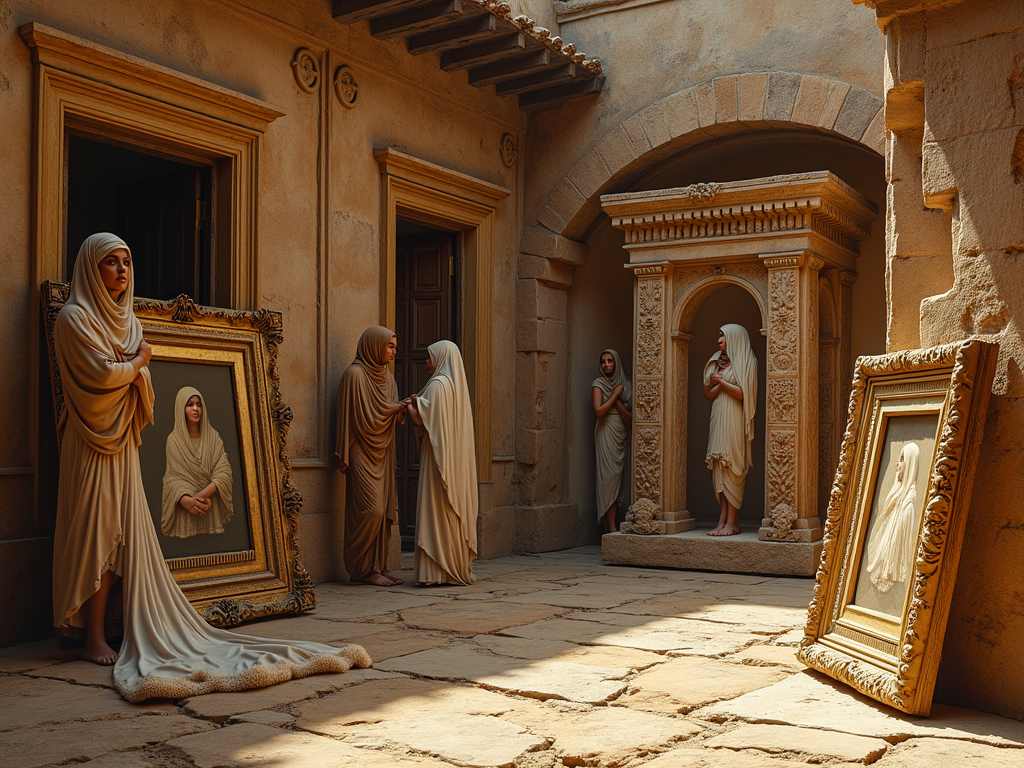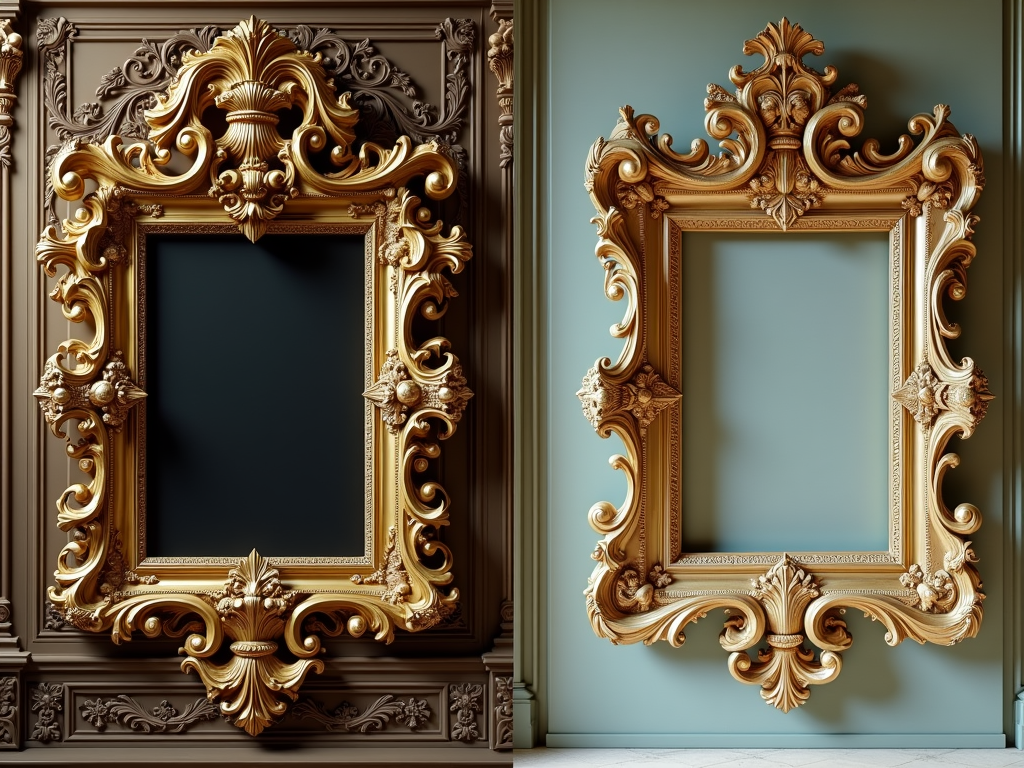
The history of picture frames began in ancient Egypt with the Fayum mummy portraits. These early examples used linen wrappings to honor the departed and preserve their images, showcasing the beginnings of framing as a meaningful practice.
The Evolution of Picture Frames
Over time, this tradition evolved during the Roman era, where carved wooden or stone frames brought greater emphasis to memory and respect. This set the stage for framing to become both an artistic and functional element in human culture.
Key Takeaways
- Fayum mummy portraits from ancient Egypt represent the first known framed artwork, utilizing linen shrouds to reflect cultural and spiritual values.
- The Romans introduced carved wood and stone frames, emphasizing family legacy and worship. These techniques expanded framing into a narrative tool.
- Gothic art in the 13th and 14th centuries blended frames and artwork with “engaged frames,” creating a unified visual experience to enhance sacred themes.
- During the Renaissance, frames became standalone artistic creations, skillfully designed to complement and enrich individual works of art.
- The Baroque and Rococo periods elevated decorative framing styles to new heights, adding grandeur or charm to emphasize the significance of the pieces within.
Frames Through Time: From Function to Art
Frames today do so much more than just hold art—they protect, enhance, and transform pieces into integral parts of a space. But this blend of utility and beauty wasn’t always the case. The earliest evidence of framing comes from ancient Egypt, specifically the Fayum mummy portraits. These wax encaustic paintings, often surrounded by the linen shrouds they accompanied, served a deeply cultural purpose. They weren’t just decorations; they honored the dead and preserved their likeness for eternity.
The Romans brought their innovations into play, using painted wooden panels and carved stone frames to spotlight family ancestry or pay homage to gods. Some of these fragments, like those found in the British Museum, highlight how these ancient societies saw frames as tools of memory and reverence. Their artistry laid the foundation for how we view frames today—not as afterthoughts but as essential to the work itself.

During the 13th and 14th centuries, Christianity’s growing influence dramatically reshaped the function and design of picture frames. The demand for religious art, especially in Gothic art, spurred the development of panel paintings with integrated frames—an approach where the frame became an inseparable part of the artwork. Known as an engaged frame, this design blurred the distinction between the painting and its border, turning the frame into an extension of the sacred imagery itself.
Altarpieces became the centerpiece of many churches, showcasing this shift. These large-scale works, often adorned with gilded frames, were designed to inspire devotion. The gold leaf not only reflected physical light but symbolized divine illumination, intensifying the sense of spirituality. As the designs progressed, frames evolved from relatively simple structures into complex, ornate styles featuring intricate carvings, religious symbols, and storytelling elements that mirrored the narratives depicted in the artwork.
Globally renowned altarpieces, like Duccio’s Maestà or Jan van Eyck’s Ghent Altarpiece, highlight this transformation. Their integrated frames serve more than decorative purposes—they guide the viewer’s focus and create a cohesive, immersive experience. These frames elevated the religious content, emphasizing its sacred significance.
The craftsmanship involved was unparalleled, with artisans devoting countless hours to carving, gilding, and sometimes painting these frames directly onto the wooden panels. These changes defined a turning point for picture frames, cementing their role as both functional and symbolic extensions of art. Early Gothic art demonstrates how these designs combined reverence with visual splendor.
The Renaissance Revolution: When Frames Became Independent Art
During the Renaissance, picture frames made a bold transformation. They stopped being just protective borders and became works of art themselves. Craftsmen began designing frames to complement individual paintings, elevating them into harmonious visual experiences. This shift wasn’t just aesthetic—it celebrated the viewer’s engagement with the artwork in a transformative new way.
Advances in woodworking and gilding took center stage. Skilled artisans carved intricate designs into wood before applying layers of gleaming gold leaf, often using gesso to achieve precise textures and details. Cassoni, or finely crafted storage chests, influenced these techniques, bringing ideas of beauty and elegance into frame-making. The new demand for custom-designed frames ensured that each piece felt unique, amplifying the impact of the painting within.
The spread of the printing press democratized global access to art, pushing frames further in their evolution. You can see this shift in iconic examples like the frame of the Mona Lisa. Its luxurious detailing reflects classical architectural elements—columns, pediments, and scrolls—that replaced the plain medieval borders. This classical influence added depth and gravitas, contrasting sharply with the earlier, simpler styles.
Frames became more than construction and ornamentation; they echoed broader cultural movements. Whether through bold gilded structures or delicate hand-crafted touches, these pieces marked an intersection of art and innovation.
https://www.youtube.com/watch?v=KUm6Z2FkV8k&pp=ygUSI25hcnJhdGl2ZXBhaW50aW5n
Baroque and Rococo Frames: The Pinnacle of Ornamentation
The Baroque and Rococo periods transformed picture frames into intricate works of art, rivaling the masterpieces they surrounded. Baroque frames, true to the era’s dramatic flair, were all about grandeur and power. Heavy gilded wood with exaggerated curves, bold S-shaped scrolls, and acanthus leaf motifs dominated the design. These frames weren’t subtle; they demanded your attention, much like the dynamic and emotional artworks they encased. Think of frames from this time like a royal declaration—they amplified the significance of the art while reinforcing the status of its owner.
By contrast, Rococo frames softened this intensity with their elegance and whimsy. Gone were the overwhelming displays of authority. These frames adopted playful asymmetry, lighter colors such as pastel gilding, and delicate ornamentation, including floral patterns and curling vines. The S-curve remained a hallmark but appeared gentler, almost dancing along the edges. This style offered intimacy, complementing the lighthearted subjects popular in Rococo art.
The visual shift between the two styles is striking:
- Baroque frames often featured rich, imposing depths evocative of cathedrals or palaces.
- Rococo frames felt more like a whisper of luxury, a kind of refined charm.
Both styles, though wildly distinct, served more than decorative purposes. They elevated the artwork while signaling the social and political ambitions of those who commissioned them.
Few examples illustrate this better than the captivating frames surrounding Rubens’ monumental Baroque paintings or the delicate framing seen in depictions of Rococo salons.

During the 19th century, industrialization reshaped not just how frames were made but also how they were valued. It became easier to replicate intricate designs, leading to a revival of historical styles like Baroque and Rococo. This aligned with a growing appreciation for ornate craftsmanship. Yet, movements like Arts and Crafts pushed back, promoting straightforward, hand-crafted frames that focused on the authenticity of materials.
Art Nouveau disrupted tradition with its flowing, organic motifs, reflected in frames featuring asymmetrical curves. In stark contrast, Cubism brought sharp edges and geometric rigidity, mirroring the artwork’s angular structure. Impressionist painters like Monet leaned toward minimalistic or liner frames, ensuring the frame didn’t outshine the soft, light-filled brushstrokes of their pieces.
By the 20th century, Modernism shifted the conversation. Frames became as simple as possible—or were cast aside entirely. Mondrian’s boldly structured, grid-like compositions often thrived within plain, linear frames, reflecting his overall aesthetic. This stripped-back approach found favor in galleries overloaded with modern visuals, where overly intricate frames felt distracting.
Interestingly, the late 20th century circled back to luxurious, ornate frames for fine art. Collectors hung paintings in gilded frames as a symbolic nod to historical prestige. While contemporary minimalism dominates many homes and modern artworks today, this oscillation between the plain and the opulent highlights the frame’s evolving purpose: part protector, part extension of art’s identity.
For a hands-on exploration of frame creation that aligns with these designs, check out this guide to making a picture frame. It’s a great way to connect to the craftsmanship behind these artistic milestones!
Framing Art in the Present Day: Conservation Meets Customization
Right now, framing is a mix of technology, science, and personal taste. Conservation framing puts preservation first. It uses features like UV-filtering glass and acid-free mats to shield artwork from fading and damage over time. These techniques ensure your piece lasts for generations without compromise.
At the same time, modern frame designs stay inspired by historical styles—think ornate gilded edges or minimalist wood—but now it’s all about customization. The frame isn’t just a supporting act; it helps tell the story of the piece and its setting.
Here’s how to choose the perfect frame:
- Match the frame’s style to the artwork (a bold abstract pairs well with simple lines).
- Consider your interior décor for cohesive design.
- Balance your budget with options like ready-made frames for affordability or custom frames for tailored precision.
For priceless works, archival materials bring peace of mind worth the investment.
Sources:
The Frame Blog
Metropolitan Museum of Art articles on framing
National Gallery of Art resources
Publications by the Professional Picture Framers Association
Museum publications on specific periods of art history
